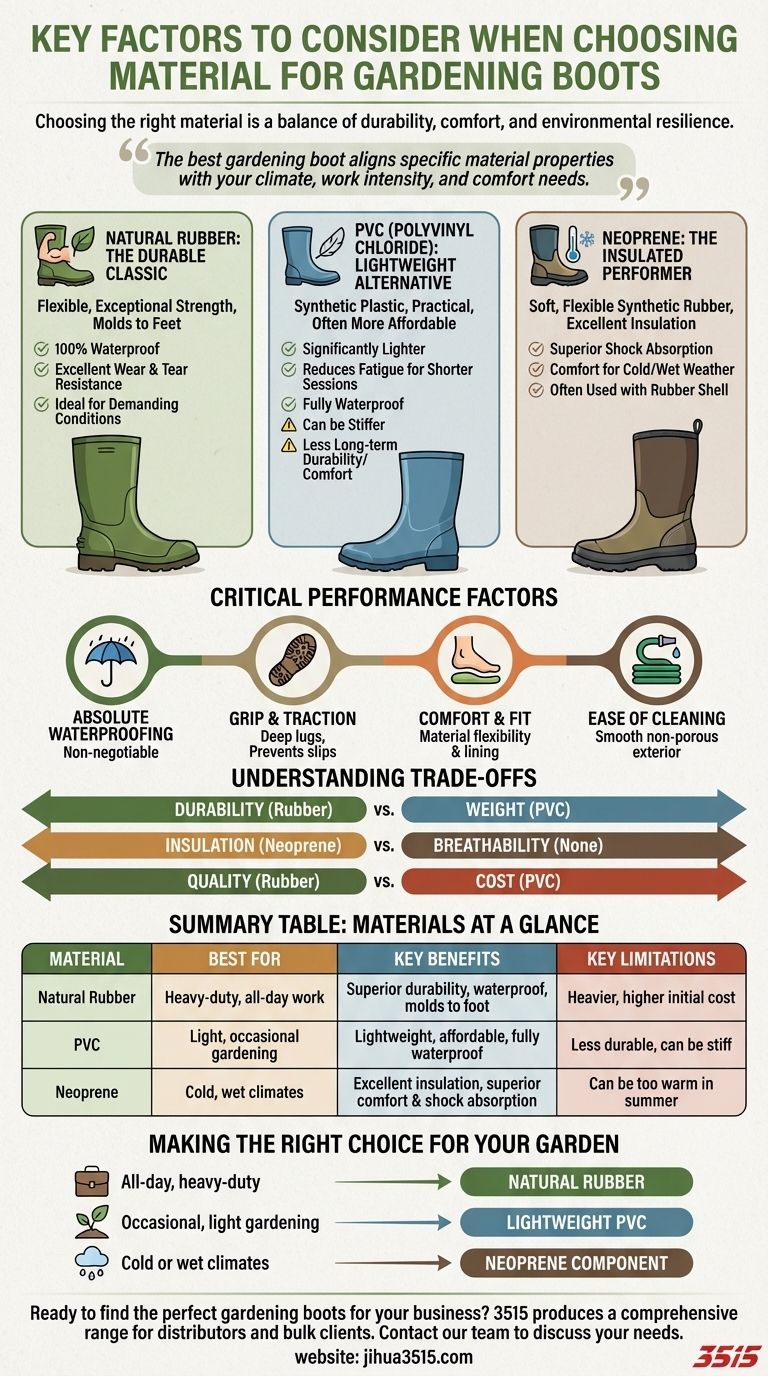Choosing the right gardening boot material is a decision between durability, comfort, and environmental resilience. Your choice primarily comes down to three materials: natural rubber for its flexible durability, PVC for its lightweight and cost-effective waterproofing, and neoprene for its superior insulation and comfort in colder climates.
The best gardening boot isn't defined by a single superior material, but by how well a material's specific properties align with your climate, the intensity of your work, and your personal need for comfort and support.

The Three Core Materials Explained
Understanding the fundamental differences between the main boot materials is the first step. Each one is engineered to solve a different set of problems you might encounter in the garden.
Natural Rubber: The Durable Classic
Natural rubber is the traditional choice for high-quality boots. It is handcrafted to be both flexible and exceptionally strong, molding to your feet over time for a more custom fit.
This material provides 100% waterproofing and excellent resistance to wear and tear, making it ideal for gardeners who spend significant time in demanding conditions.
PVC (Polyvinyl Chloride): The Lightweight Alternative
PVC is a synthetic plastic that offers a practical and often more affordable alternative to rubber. These boots are significantly lighter, which can reduce fatigue during shorter gardening sessions.
While fully waterproof, PVC can be stiffer than rubber and may not offer the same level of long-term durability or comfort for all-day wear.
Neoprene: The Insulated Performer
Often used in combination with a rubber shell, neoprene is a soft, flexible synthetic rubber that provides excellent insulation. It's the same material used in wetsuits.
Boots with a neoprene upper offer exceptional shock absorption and comfort, making them the superior choice for gardening in cold, wet weather.
Beyond Material: Critical Performance Factors
While the primary material is key, its effectiveness is supported by other crucial design elements that dictate the boot's overall performance and safety.
Absolute Waterproofing
This is a non-negotiable feature. Whether the boot is made of rubber, PVC, or a neoprene blend, its primary job is to keep your feet completely dry from external moisture.
Grip and Traction
The material and design of the outsole are critical for safety. Deep lugs and a high-traction pattern prevent slips and falls on wet soil, slick grass, or muddy paths.
Comfort and Fit
A boot's comfort is a function of its material flexibility, interior lining, and sole design. Features like anti-fatigue footbeds and shock-absorbing materials like neoprene significantly reduce strain during long hours of work.
Ease of Cleaning
Gardening is inherently messy. The exterior material should be smooth and non-porous, allowing you to easily hose off mud and soil without extensive scrubbing.
Understanding the Trade-offs
No single material is perfect for every situation. Choosing the right one involves balancing competing benefits and understanding their inherent limitations.
Durability vs. Weight
Natural rubber offers superior longevity and resilience but comes with added weight. PVC provides a lightweight, easy-to-wear experience but may crack or wear out faster under heavy use.
Insulation vs. Breathability
Neoprene is unmatched for warmth, but that insulation can make boots uncomfortably hot in summer. Fully waterproof boots are, by nature, not breathable; comfort in warm weather depends on moisture-wicking linings, not the outer material.
Quality vs. Cost
Handcrafted natural rubber boots represent a higher initial investment but often last much longer. PVC boots are more budget-friendly upfront but may need to be replaced more frequently, potentially costing more in the long run.
Making the Right Choice for Your Garden
Your ideal boot material is a direct reflection of your gardening habits and environment. Use your primary needs as a guide to making a definitive choice.
- If your primary focus is all-day, heavy-duty work: Choose a high-quality natural rubber boot for its unmatched durability and supportive fit.
- If your primary focus is occasional, light gardening in mild weather: A lightweight PVC boot provides essential waterproofing and is an excellent, economical choice.
- If your primary focus is gardening in cold or wet climates: Prioritize a boot with a neoprene component for crucial insulation, flexibility, and comfort.
By aligning the material's core strengths with the demands of your garden, you ensure your boots become a reliable and comfortable tool for the work ahead.
Summary Table:
| Material | Best For | Key Benefits | Key Limitations |
|---|---|---|---|
| Natural Rubber | Heavy-duty, all-day work | Superior durability, 100% waterproof, molds to foot | Heavier, higher initial cost |
| PVC | Light, occasional gardening | Lightweight, affordable, fully waterproof | Less durable, can be stiff |
| Neoprene | Cold, wet climates | Excellent insulation, superior comfort & shock absorption | Can be too warm in summer |
Ready to find the perfect gardening boots for your business?
As a large-scale manufacturer, 3515 produces a comprehensive range of durable, comfortable, and waterproof footwear for distributors, brand owners, and bulk clients. Our production capabilities encompass all types of gardening boots, ensuring you get the right product for your market.
Contact our team today to discuss your specific needs and discover how we can support your business with high-quality, reliable footwear.
Visual Guide

Related Products
- Factory-Direct Wholesale Canvas Boots with High-Traction Rubber Soles
- Factory Direct Wholesale Rain Boots Durable Waterproof & Fully Customizable
- High Performance Fire-Retardant Waterproof Safety Boots
- Premium Wholesale Waterproof Safety Boots High Performance Protection for Industrial Markets
- Wholesale High-Traction Camo Boots - Custom Manufacturer for Brands
People Also Ask
- What factors determine the slip resistance of rubber-soled shoes? Tread, Compound & Design Explained
- What should be avoided when storing boots with outsoles? Protect Your Investment from Dry Rot & Decay
- What role do slip-resistant rubber materials play in safety shoes? Ensuring Grip and Stability in Hazardous Workplaces
- What types of work environments are hiker-style rubber outsoles best for? Ideal for Outdoor & Industrial Safety
- What is a vulcanized sole? Discover the Secret to Superior Flexibility and Grip



















